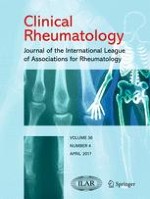Erschienen in:

26.01.2017 | Original Article
Human cytomegalovirus (HCMV) UL44 and UL57 specific antibody responses in anti-HCMV-positive patients with systemic sclerosis
verfasst von:
Emmanouela Marou, Christos Liaskos, Theodora Simopoulou, Georgios Efthymiou, Efthymios Dardiotis, Christina Katsiari, Thomas Scheper, Wolfgang Meyer, Georgios Hadjigeorgiou, Dimitrios P. Bogdanos, Lazaros I. Sakkas
Erschienen in:
Clinical Rheumatology
|
Ausgabe 4/2017
Einloggen, um Zugang zu erhalten
Abstract
The role of human cytomegalovirus (HCMV) has been postulated as a trigger of systemic sclerosis (SSc). The aim of the study was to assess the prevalence of antibodies against HCMV UL44 and UL57 antigens not tested in the past. Sixty SSc patients, 40 multiple sclerosis and 17 normal controls (NCs), all anti-HCMV positive, were tested by immunoblotting. Reactivity to HCMV antigens, expressed as arbitrary units (AUs), was assessed for correlation with clinical and immunological parameters, including types of SSc-related autoantibodies. Anti-UL44 and anti-UL57 HCMV antibodies were present in 3/60 (5%) and 58/60 (96.7%) SSc patients, respectively (p < 0.001). Anti-UL57 antibodies were present in 35/40 (87.5%) MS patients and 16/17 (94.1%) NCs (SSc vs MS, MS vs NC, p = ns). Strong (50-75 AU) and very strong (75–100 AU) anti-UL57 immunoreactivity was found in 24 (41.4%) and 22 (37.9%) SSc patients, respectively (p = ns). Dilution experiments showed anti-UL57 antibody persistence in up to 1/5000. Overall, there was no difference in the frequency or the magnitude of anti-UL57 immunoreactivity between diffuse cutaneous systemic sclerosis and limited cutaneous systemic sclerosis patients (96.67 vs 96.67%; 65.45 ± 20.19 vs 64.31 ± 21.11 AU, p > 0.05) but strong anti-UL57 reactivity were more frequent in SSc compared to NCs (p = 0.007). Anti-UL57 reactivity was not inhibited by SSc-specific autoantigens. Anti-UL57 seropositivity did not correlate with demographic, clinical or immunological features of SSc. Anti-HCMV UL57 antibodies are universally present in anti-HCMV-positive patients with SSc, while those against UL44 are rarely seen. Because anti-UL57 lack disease specificity and are not involved in cross-reactive responses, their immunopathogenetic potential is to be questioned.